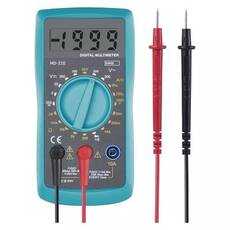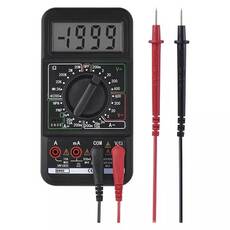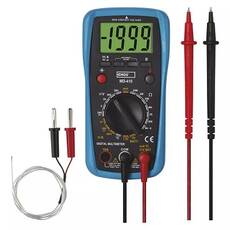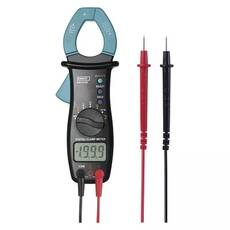Multimeters
A multimeter is a very versatile measuring instrument that measures electrical values such as resistance, frequency, DC and AC voltage, and displays the result in volts, ohms, amperes, hertz or farads. This is why it is also called a voltmeter, ammeter or ohmmeter. This measuring instrument can be used for home as well as professional purposes. Not only can it be used for measuring, but it is also perfect for testing devices, troubleshooting and diagnosis. The high quality instrument can also measure battery capacity, frequency and temperature. Using this measuring device is very simple, so there are few problems. For home use, a version with less knowledge is usually sufficient. Among industrial multimeters there are also so-called desktop multimeters. Read more...
• Range selection: manual
• AC voltage: 200-300 V
• DC voltage: 200 mV - 300 V
• DC current: 20 µA - 10 A
• Electrical resistance: 200 Ohm - 2 MOhm
• Conductor continuity
• Diode testing
• Display display: 3.5 digit
• Low battery indication
• Dimensions: 27 × 70 × 135 mm
• Power supply: 1× 9 V (included)
• Accessories: battery, manual, measuring tips, protective case
• Range selection: manual
• AC voltage: 2-600 V
• AC current: 2 mA - 10 A
• DC voltage: 200 mV - 600 V
• DC current: 2 mA - 10 A
• Electrical resistance: 200 Ohm - 20 MOhm
• Conductor continuity
• Diode testing
• Transistor testing
• Display display: 3.5 digit
• Low battery indication
• Dimensions: 32 × 85 × 165 mm
• Power supply: 1× 9 V (included)
• Supplied with battery, manual, measuring tips
• Range selection: manual
• AC voltage: 200 mV - 300 V
• AC current: 20 mA - 10 A
• DC voltage: 200 mV - 300 V
• DC current: 20 mA - 10 A
• Electrical resistance: 200 Ohm - 20 MOhm
• Conductor continuity
• Diode testing
• Non-contact AC voltage detection
• Battery testing
• Recording readings
• Display display: 3.5 digit
• Low battery indication
• Backlighting
• Dimensions: 168 × 83 × 35 mm
• Power supply: 1× 9 V (included)
• Accessories: battery, manual, measuring tips
• Range selection: automatic and manual
• AC voltage: 600 mV - 750 V
• AC current: 600 µA-10 A
• DC voltage: 600 mV - 1 000 V
• DC current: 600 µA-10 A
• Electrical resistance: 600 Ohm - 60 MOhm
• Continuity of conductor
• Diode testing, transistor testing
• Max. value recording
• Recording readings
• Automatic switch-off
• Display: 5 3/4 digit
• Low battery indication
• Backlighting
• Dimensions: 35 × 90 × 190 mm
• Power supply: 1× 9 V (included)
• Accessories: battery, measuring tips, reduction for measuring transistors, temperature probe type K
• Range selection: automatic
• AC voltage: 4-600 V
• AC current: 400 A
• DC voltage: 400 mV - 600 V
• DC current: 400 A
• Electrical resistance: 400 Ohm - 40 MOhm
• Continuity of conductor
• Diode testing
• Recording readings
• Automatic switch-off
• Display 3 3/4 digit
• Low battery indication
• Dimensions: 38 × 71 × 194 mm
• Power supply: 2× 1.5 V AAA (included)
• Accessories: battery, manual, measuring tips
• Crocodile clip - banana plug
• 93 cm
• Black / Red
What are the components of a multimeter?
This device consists of four basic parts, the display where the results of the measurements are shown. The selection buttons and the ports, and the red and black probes that you plug into the ports.
Where does the name multimeter come from?
Multimeter specifically means multiple measuring device. The first part of this compound word comes from the Latin word multus, meaning many, and the second part comes from the Greek word metron, meaning distance, measure or circumference.
What are the different types of multimeter?
There are two types of multimeters. There are analogue and digital multimeters.
- Properties of the analogue multimeter:This type of instrument displays the measured value by means of a pointer swing and different scales. This analogue instrument is usually equipped with a mirror scale, which makes it easy to read accurate values. Analogue multimeters usually measure quickly, but their values are less accurate. Since the 1990s, they have been increasingly replaced by digital versions.
- Features of the digital multimeter: This type of measuring instrument shows us the measured value in numerical form on the display. Most digital multimeters have an LC display. The measuring ranges are from 20 mA to 20 A for current and from 200 mV to 1000 V for voltage. When measuring resistance, the instrument covers a range from 200 ohms to 2000 kOhm. Unlike analogue multimeters, digital versions measure more slowly but much more accurately. This is why many professionals use them as testers or battery testers. In addition to voltage, current and resistance, modern digital multimeters can also measure temperature, frequency and capacitance.
- What additional features do digital multimeters have? They can be used for non-contact voltage detection, cable break testing, diode testing, but also for phase detection with light and sound signals, and inductance measurement. A professional digital multimeter has an automatic shutdown function and can store the measured data.
What are the advantages and disadvantages of a multimeter?
Both analogue and professional digital multimeters have almost the same basic features, even if they differ slightly in terms of handling. The advantage of such a device is that you don't need to buy many different measuring instruments, as it is a voltage, current, temperature, capacitance and resistance meter in one. It allows fast and accurate measurements and is easy to use. However, reading and interpreting the data requires technical knowledge.
What is the maximum measuring range of a multimeter?
Depending on which industrial multimeter you choose, the voltage measurement range can be up to 1000 V, the frequency measurement range up to 30 MHz, the capacitance measurement range up to 60 000µF, the DC resistance up to 50 MΩ.
How to calibrate the multimeter?
The calibration of the analogue and digital multimeter is carried out in an accredited laboratory, the purpose of which is to verify by measurement that the accuracy of the instrument meets the expected requirements. During calibration, it is established that there is a correlation between the value indication of our multimeter and the correct value of the quantity to be measured. So calibration is the process of establishing the metrological characteristics of a measuring instrument, at the time and under the conditions specified.
What safety measures must be observed when using a multimeter?
Strict safety precautions must be observed when working with electricity, as there is a risk of electric shock when taking measurements. Of course, never work on live equipment because, if a component or wire is live, it can easily cause a short circuit. The condition of the wiring should also be checked regularly. Make sure that the mains voltage is measured directly at the terminals of the power source and that you always keep your fingers on the plastic and rubber parts of the multimeter. Wear protective goggles when carrying out measurement tasks!
If you have any further questions about the multimeter instruments, we are happy to help you either in person at our shop or by contacting us.







